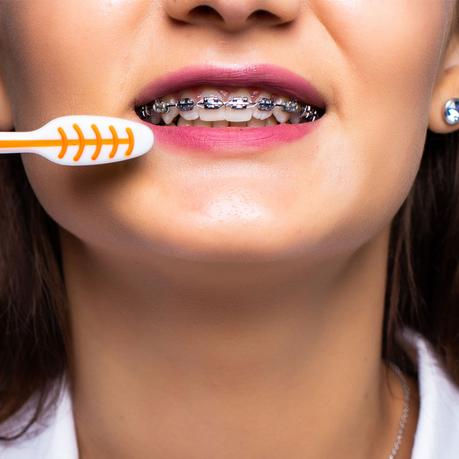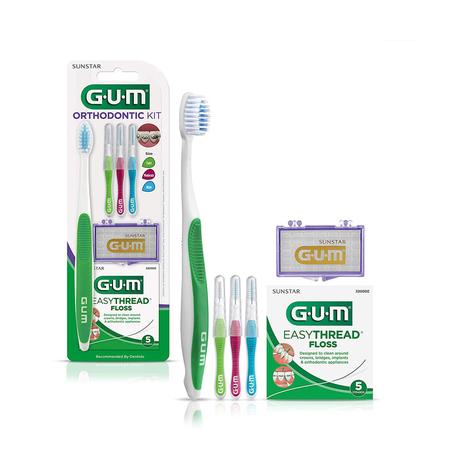
Brushing your teeth is an important step to good dental hygiene to remove the food and plaque left behind after eating. In the case of toothbrushes for braces, both electric and manual toothbrushes are designed to help you clean your teeth and protect your braces. When you’re wearing braces, it becomes a bit more challenging, as the wires offer food and more places to hide.
Compare Toothbrushes for Braces
Manual Toothbrushes
When choosing a toothbrush, always check to ensure that it’s an Ortho toothbrush(toothbrushes for braces) and that the bristles are soft or extra-soft, which means that it’s been specially designed to be used on braces. Different toothbrush manufacturers will give them different names, but they’ll all have one similar design a V-Trim in the bristles. The longer outside bristles can properly reach your gums and teeth.
Electric Toothbrushes
All major electric toothbrush manufacturers have considered braces when designing their products. Since these brushes are designed to gently clean hard-to-reach areas of your mouth, they’re ideal for braces in comparison with other toothbrushes for braces.
Invisalign Users
Brushing and flossing are still important! But what if, instead of braces, you received the Invisalign treatment from your orthodontist?
You’ll have to brush with a soft toothbrush and floss every time you eat and before you reinsert your aligners.
Most of these companies have also created brushes specially designed for use with braces, adding to the benefit of going electric over manual.
How To Brush Your Teeth with Braces
your brace’s oral hygiene routine is important to the success of your orthodontic treatment; it consists of brushing, flossing and mouthwash; start with brushing first brush after every meal and snack; if possible, brushing at night is the most important. To prevent plaque buildup overnight, you’ll need three brushes to get the job done one a proxy brush to a manual orthodontic toothbrush or power brush and three a Selca brush or power tip start with a proxy brush to remove chunks of food that are stuck between your teeth and braces the next brush you’ll need is either a manual orthodontic toothbrush or a power brush. You’ll need to use three brushing positions for each side of each tooth: a 45-degree angle on the tooth and a gum line pointing from the gum toward the tooth. A straight angle on the surface of the bracket, a 45-degree angle from the tooth toward the gum. The targets under the bracket with a powerbrush, hold the brush in each position for at least 5 seconds, then move on to the next tooth; if you’re using a manual orthodontic toothbrush, move the brush in a circular motion; we recommend five circles for each brushing position. Don’t forget to brush all sides of your teeth using the same three positions as well as the chewing surfaces of your teeth; by positioning the brush on top of the chewing surface, you’re almost finished; when you’re done with your regular toothbrush use this narrow Selca brush or replace the head of the power brush with a smaller power tip. A Selca brush or power tip is great at getting under the brackets and at the gum lines; repeat all three positions on the front and back of each tooth. Make sure to spend time with each tooth to ensure a thorough cleaning. Voila, you’re done. Don’t forget most objects attract bacteria; it’s important to keep your brush in a clean and dry environment and to change your brush frequently. Use these brushing with braces tips every day for the duration of your orthodontic treatment. After brushing, remember to complete your brace’s oral hygiene routine with flossing and mouthwash.
How to Use a Proxy Brush to Help Keep Your Braces
the proxy brush is a nylon bristle brush intended to clean between the teeth. Place it under the archwire in between two teeth, then move it up and down, cleaning the edge of the bracket toward the back. In between the two teeth, then the edge of the bracket toward the front.
QUALITY AFFORDABLE DENTAL IMPLANTS
Copperhills Family Dentistry specialists provide specialized dental services that help our patients cultivate healthy and happy smiles. We’re happy to provide compassionate care coupled with cutting-edge technology.
Dental implantHow Are Your Brushing Habits?
You could have the best toothbrushes for braces, but they aren’t much help if you have poor technique. Unfortunately, those who wear braces find themselves at greater risk for dental decay.
It’s important to not only brush your teeth but the braces themselves. Even more important is reaching the space between the bone and the metal. Consider investing in a water flosser to use instead of traditional strings. The added obstacles make it challenging to keep everything clean.

Teeth
Whitening
cosmetic
dentistry
dental cleaning
and checkups
How to Maintain your Teeth with Braces
We’re going to go over how to take care of your braces. Now that you have your braces on, you have to learn how to eat your food differently. As far as anything hard: raw fruits, vegetables, pizza, french bread; anything that’s hard or mildly hard, you want to get into the habit of cutting it up or tearing it up and placing it into the back. You’re not going to want to use your front teeth to bite down into anything. The pressure from that will cause your brackets to fall off. Also, as far as candy, you can’t have anything chewy or sticky: bubble gum, now or later, Laffy taffy, you can’t have any of that because that will also cause breakage.
We’re going to go over how to brush your teeth. It’s very important with braces that you get under and over your brackets when you brush your teeth. You want to make sure that you remove all the film away from your teeth. Otherwise, if that film sits on your teeth, it will turn into plaque, get hard, and start to form cavities on your teeth. When you floss your teeth, this is called super floss, a unique floss. It comes in a little bag.
What’s unique about this floss is that you have a little plastic part, a spongy part, and floss, all in one strand. You’re going to take the plastic part and thread it through just like this. You’re going to use the spongy part to clean around the brackets, and then you have the actual floss to floss into your gum line.
You must floss every day. And then you also have some fluoride rinse. You don’t have to use this particular brand, but anything with fluoride in it, I want you to swish around with it before you go to bed at night for 30 seconds. Swish around with it for 30 seconds; after that, you can’t have anything to eat or drink for 30 minutes there afterwards. So it should be the very last thing you should do after you brush your teeth.
You’ll sometimes notice with your braces on; you might have a wire poking you or a bracket bothering you. What you’re going to do with the wax, you’ll take a little piece of wax, roll it up into a little ball, you’ll place it over the bracket or the wire, kind of creates like a little band-aid on the inside of your mouth so you can’t feel anything. Less is best with the wax. Also, you have some Orabase. You will notice that sometimes you will get little sores on the inside of your mouth. You must use a kind of like a little numbing cream. If that were to happen, you just take a little piece of this, rub it on the inside of your cheek, and numbs it and makes it feel better. Also, you’re going to get a little travel toothbrush. When you’re out with family or in school, you’ll notice that food will get stuck between the wire and the bracket. When you brush, just go over and under to get all the food out. Also, you’ll notice when you eat your food that the food will get stuck between the wire and the bracket. This is called a proximal brush. You’ll take this brush and thread it through the wire and the bracket. Just be careful not to yank or pull; you don’t want to break the bracket.
Also, we’re going to go over how to wear your rubber bands. You must wear your rubber bands 24 hours a day. Hypothetically, if you go to bed a 9 p.m., I’d like you to take that rubber band off and switch it to another one every night.
That’s exactly how you’re going to be wearing your rubber bands. You must wear these 24 hours a day. When you come in for your appointments, we can tell if you’ve been wearing them. It will help fix your jaw relationship, so you’ve got to make sure you’re being compliant with us. If you notice you have anything broken, call your dentist. We can get you in here and get it fixed; it can put you back in treatment some, so be mindful if you have anything broken.

